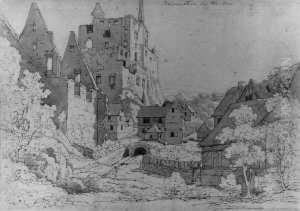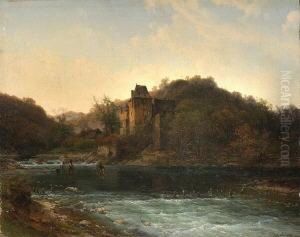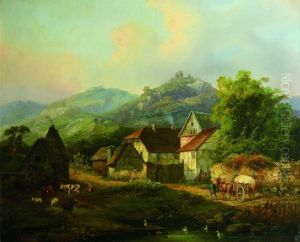Johann Adolf Lasinsky Paintings
Johann Adolf Lasinsky, a German artist primarily known for his landscape paintings and lithographs, was born in 1808 in Koblenz, a city on the Rhine River. His artistic journey began under the tutelage of his father, who was also an artist. Lasinsky's work was deeply influenced by the picturesque and romantic landscapes of the Rhineland, which he depicted with meticulous detail and a fine sense of atmosphere in his lithographs and paintings.
Lasinsky trained as an artist in Düsseldorf, which, during the early to mid-19th century, was a hub for art and artists in Germany. The Düsseldorf School of Painting, with which he was associated, was known for its focus on nature, detailed landscapes, and a romanticized view of the countryside. This school of painting was characterized by its attention to detail, composition, and use of color, and Lasinsky's work often exemplified these qualities.
During his career, Lasinsky traveled extensively along the Rhine, capturing the essence of its castles, towns, and rural landscapes. His works served as visual documentation of the region during his lifetime and provided a romanticized glimpse into the Rhineland's past. He collaborated with other artists to produce series of topographical views, which were popular among tourists as well as locals who appreciated the idyllic representations of their surroundings.
Johann Adolf Lasinsky's contribution to the world of art is found in his ability to convey the grandeur and beauty of the German landscape in the 19th century. He captured the changing times, from the romantic era to the burgeoning industrial age, through his detailed and atmospheric landscapes. His lithographs, in particular, were praised for their clarity and precision, which were a result of his mastery of the medium. Lasinsky's work remains a valuable historical record of the Rhineland and is collected and studied for both its artistic and documentary value.
Lasinsky passed away in 1871, leaving behind a legacy of work that continues to be appreciated for its technical skill and romantic portrayal of the German landscape. His art captures the essence of a bygone era and remains significant for those interested in the Rhineland's cultural and historical heritage, as well as the broader scope of 19th-century European art.


